Original text: https://data.parity.io/eoyr2024
Author: Parity
Compiled by: OneBlock+
Recently, the Parity team released the "2024 Polkadot Year-end Report" , and OneBlock+ compiled and sorted out the key points of the report. The report is based on real on-chain data provided by DotLake, and comprehensively shows the development achievements of the Polkadot ecosystem in the past year. The report covers many core areas of the Polkadot ecosystem, including resilience and decentralization, throughput, scalability, governance, ecosystem growth, interoperability, ecosystem developers, and the 2025 roadmap. The following are the main highlights of the Polkadot ecosystem in 2024 mentioned in the report:
The innovative Coretime model was launched to reform the block space purchasing mechanism, supporting on-demand and bulk purchases.
The network performance achieved a breakthrough, reaching a record high of 143,000 TPS in the Spammening test.
Technological upgrades have significantly improved efficiency, and asynchronous support has halved the Rollup block generation time from 12 seconds to 6 seconds.
On-chain activity continued to be strong, with monthly transaction volume increasing by 200% from 13.1 million in January to 39.6 million in November.
The developer community remains vibrant , with 1,273 developers active in more than 270 open source code repositories.
The governance mechanism worked well, with OpenGov initiating more than 950 proposals throughout the year, of which more than 520 were passed.
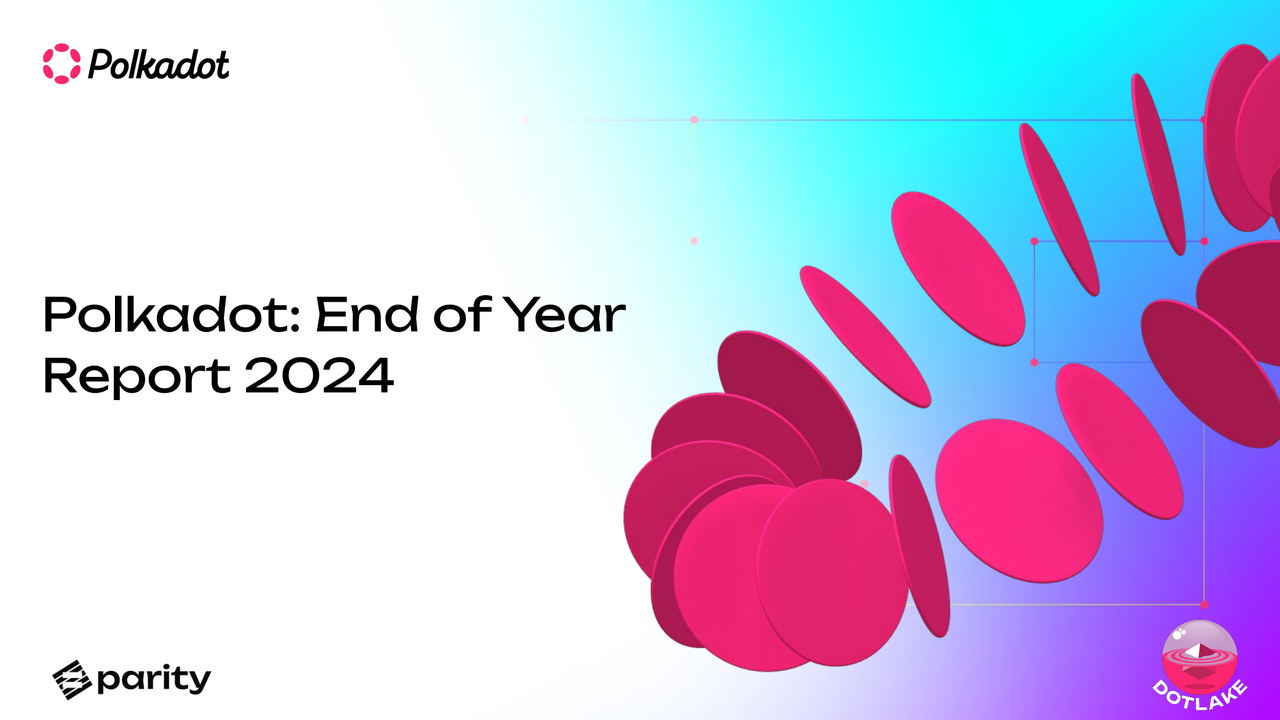
Enhance decentralization and network resilience:
Security of the Polkadot ecosystem
As of November 2024, the number of Polkadot validators has increased from 297 to 500 , greatly improving the degree of decentralization and system resilience. At the same time, the DOT staking rate has reached 52.5%, with a total amount of more than US$8 billion. The sufficient staking incentive mechanism effectively ensures the honest behavior of validators.
To ensure the long-term sustainability of Polkadot, Polkadot has adopted a new inflation model , which gradually decreases from a constant inflation rate of 8%, which will generate approximately 120 million DOT tokens in the first year. The new inflation model ensures that validators can receive sustainable rewards to continue to maintain network security, while allocating 15% to the treasury to continue to promote the development of the ecosystem.
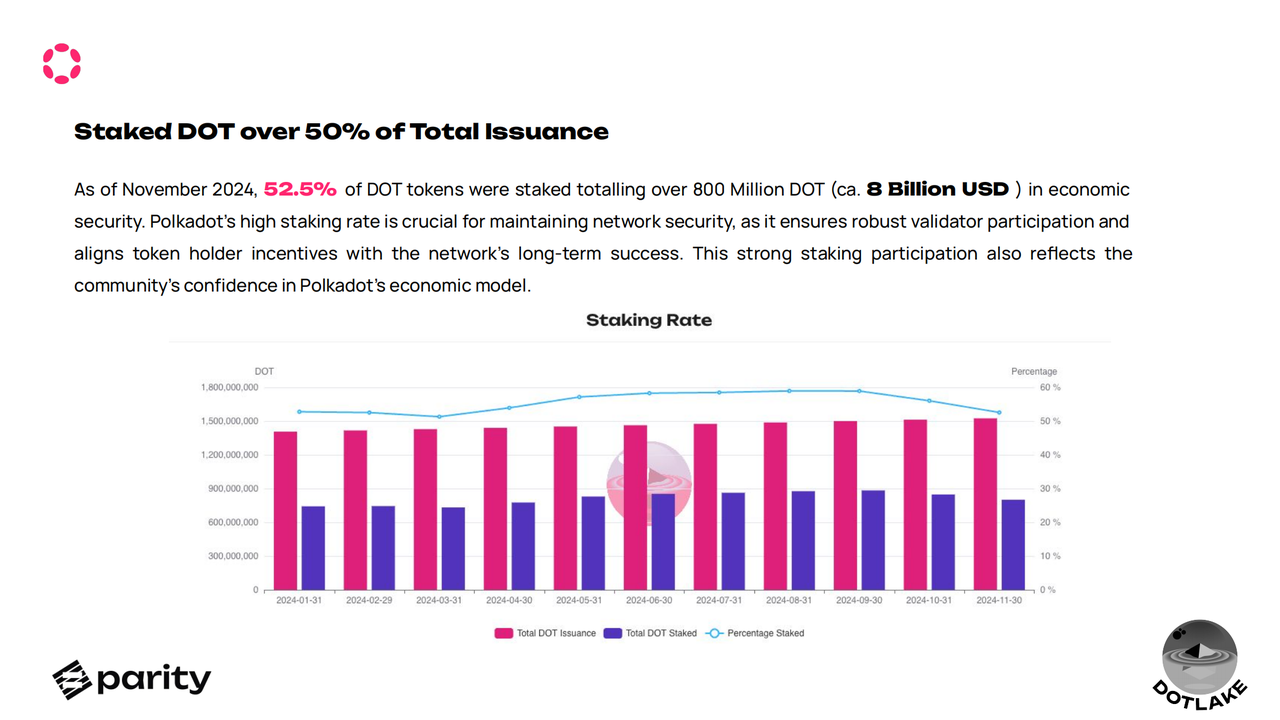
Nomination staking pool size expansion
There are currently 229 nominated staking pools on the Polkadot network, with more than 44,000 members staking approximately 22.1 million DOTs . By the end of October 2024, the number of unstaked DOTs continued to increase, rising from the annual high of approximately 60 million DOTs in March to 80 million DOTs in November. The number of unstaked DOTs usually increases during market fluctuations, especially in April and October, when there were two significant peaks.
Relay chain performance is stable
The relay chain showed stable block production efficiency in 2024, with an average daily block production time close to the expected 6 seconds. 99.49% of blocks were produced within 7 seconds, 99.99% of blocks were produced within 30 seconds, and only 9 blocks exceeded this time threshold. Even during multiple high-frequency transactions (such as multiple Rollup transactions), there was no significant increase in block production time, showing the stability and resilience of the network.
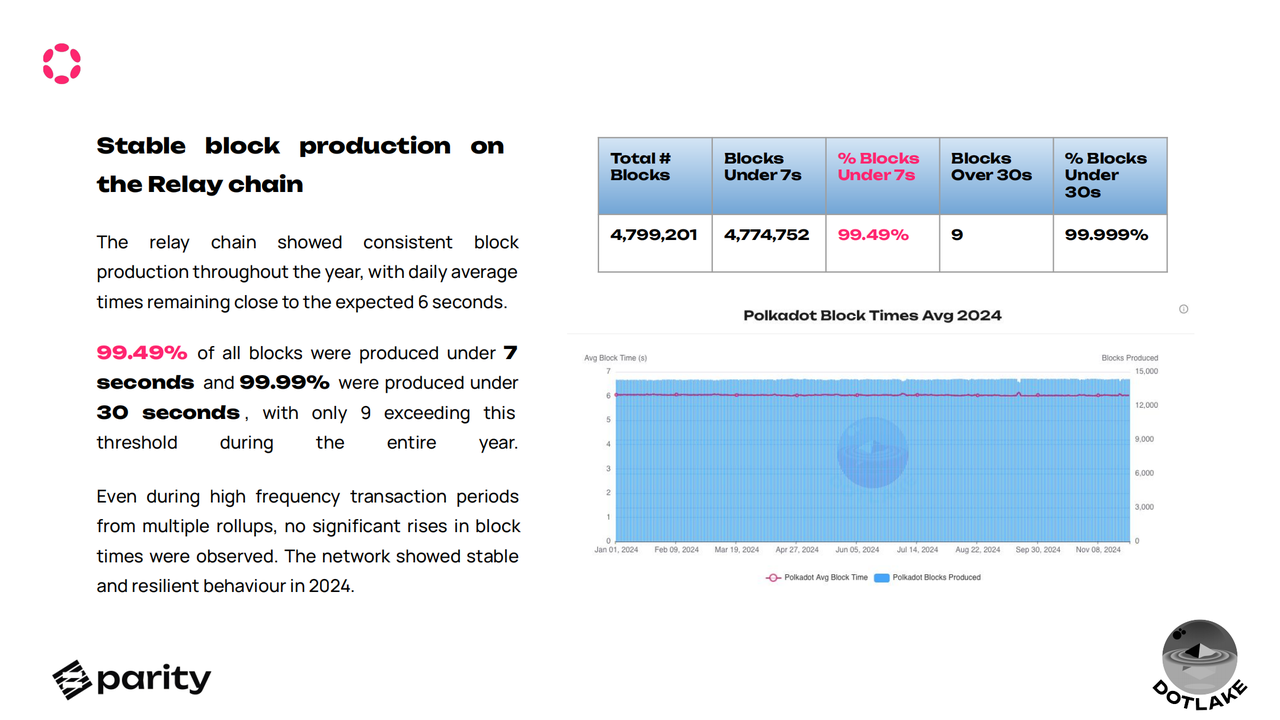
Spammening Test:
Challenging the limit of throughput performance
On December 4, 2024, the Kusama network conducted a real-time stress test called "Spammening", with a peak transaction throughput (TPS) of 143,000 transactions per second. During the test, the cumulative number of batch transfer calls exceeded 103 million times, and nearly 4 million calls were executed every 30 seconds. At the same time, the average final confirmation time of Rollup dropped to 11.8 seconds, and the overall average confirmation time was 16.58 seconds.
Transaction fees remained stable during the test, with an average fee between $0.02 and $0.15, with the only abnormal peak occurring in one call, reaching $8, but not related to the test activity. During the experiment, more than 60,000 signed transactions were recorded from existing Rollups, with nearly 3,000 transactions processed every 30 seconds, eventually stabilizing at more than 1,500 transactions. This test fully verified the high throughput capacity of the Polkadot network when multiple Rollups run in parallel.
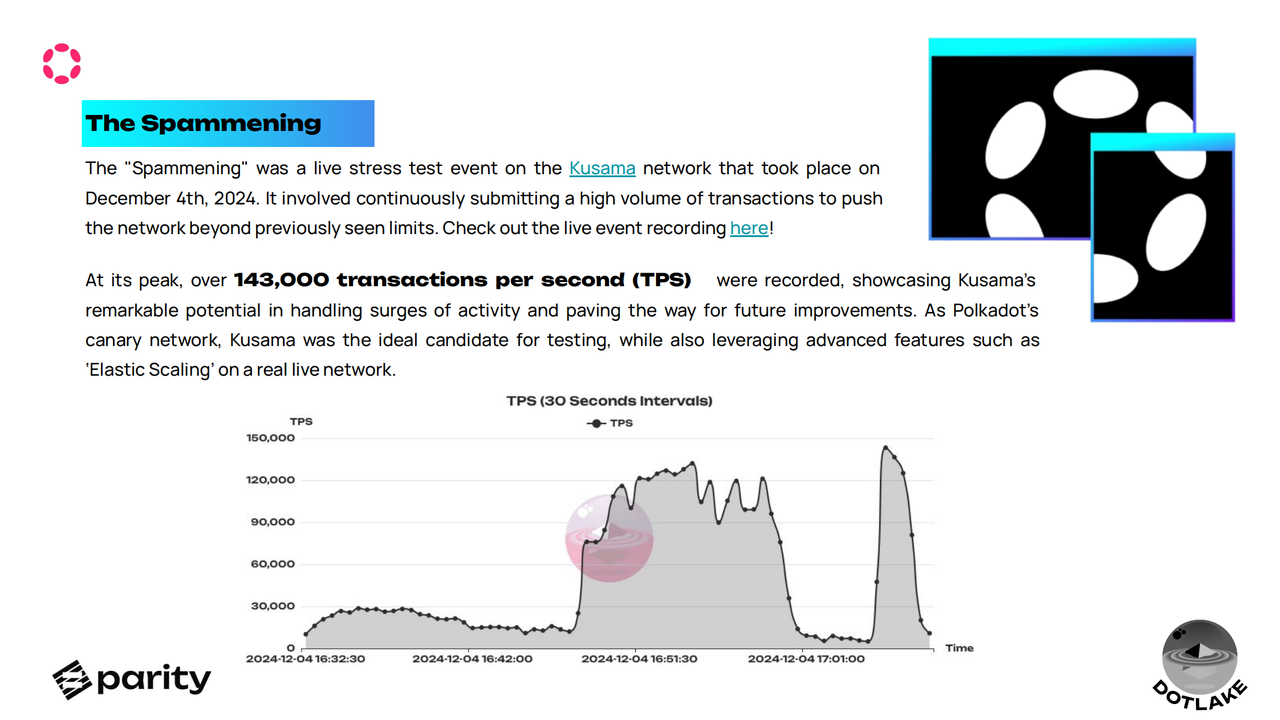
Scalability: Coretime Model and
Asynchronous support for dual drivers
Agile Coretime Model
Agile Coretime provides flexible block space allocation options, including on-demand Coretime that allows Rollups to obtain block space on demand; batch Coretime provides long-term, predictable allocations for projects with long-term needs. Teams can trade excess block space, monetize unused allocations, and obtain additional resources on demand.
Coretime sales use a Dutch auction mechanism, where the price starts from a predefined starting price (start_price) and gradually decreases over time (in blocks) until it reaches the market equilibrium price (regular_price) and is maintained at a fixed price stage. This phased pricing approach ensures fair market value and encourages users to actively participate in price discovery. As of October 2024, the Polkadot network has completed 23 Coretime sales, with a total revenue of approximately 844 DOT, all of which have been destroyed.
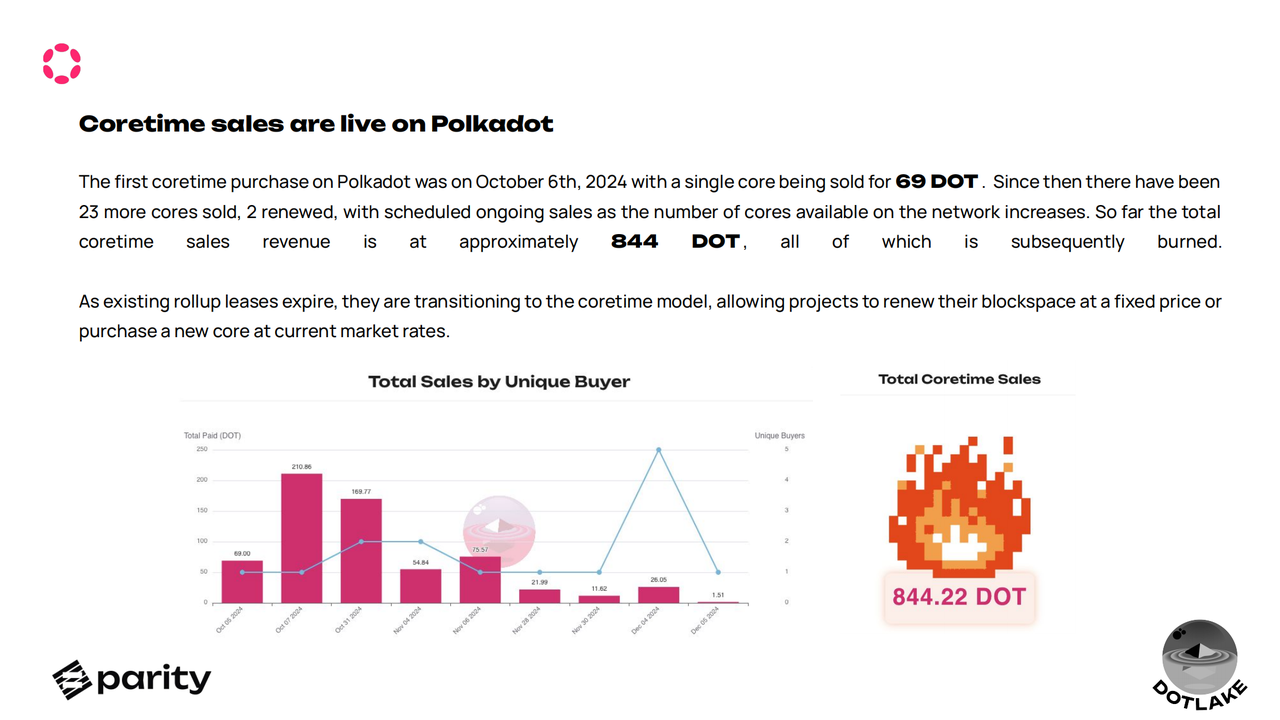
Asynchronous support speeds up throughput
The introduction of asynchronous support reduces the block time of Rollup from 12 seconds to 6 seconds , greatly improving throughput and transaction confirmation speed. Through parallel transaction verification and pipeline processing technology, network performance has been significantly optimized. Taking Moonbeam and Mythos as examples, after the upgrade, their block time dropped from an average of 12 seconds to 6 seconds, significantly improving network efficiency.
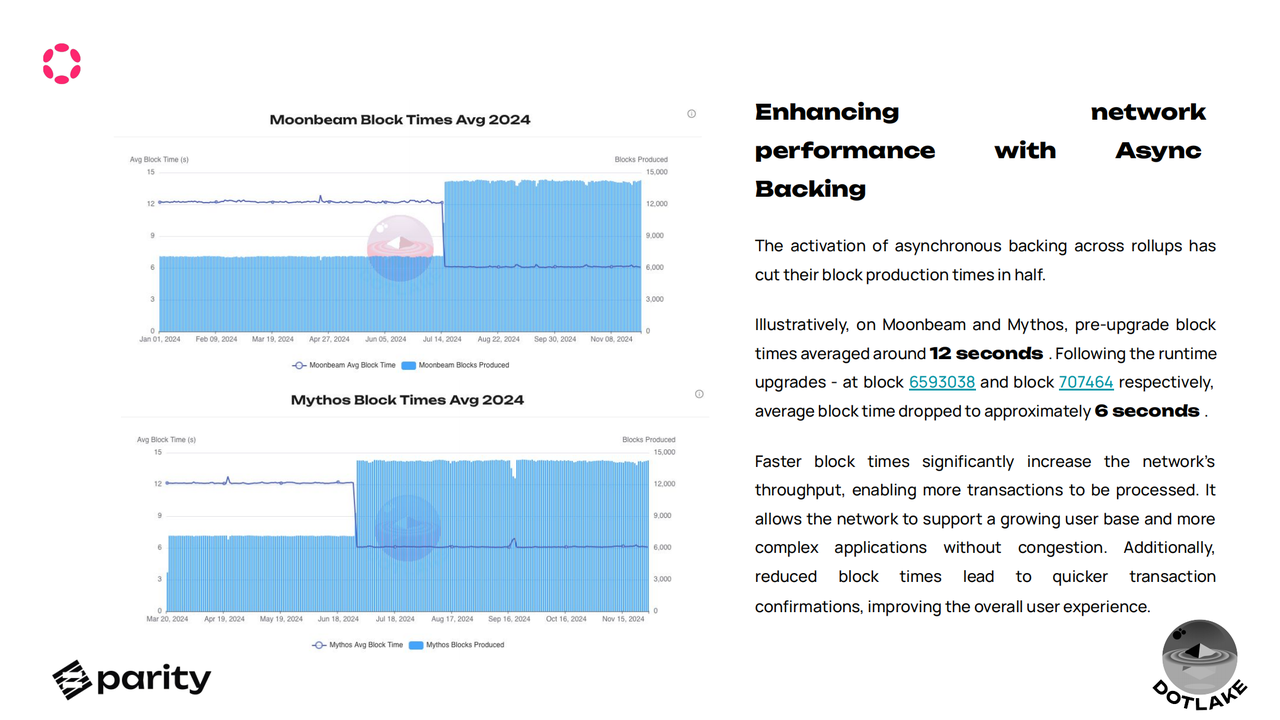
Polkadot AssetHub
and Mythos users surge
In 2024, the number of new account registrations in the Polkadot ecosystem saw three significant increases in March, June, and October. Among them, AssetHub created millions of new addresses during the launch of the ecosystem token, and Mythos also created millions of new addresses during the migration from Ethereum to Polkadot. Mythos' monthly new accounts increased from 180,000 in September to 5 million in October, a month-on-month increase of 2662% .
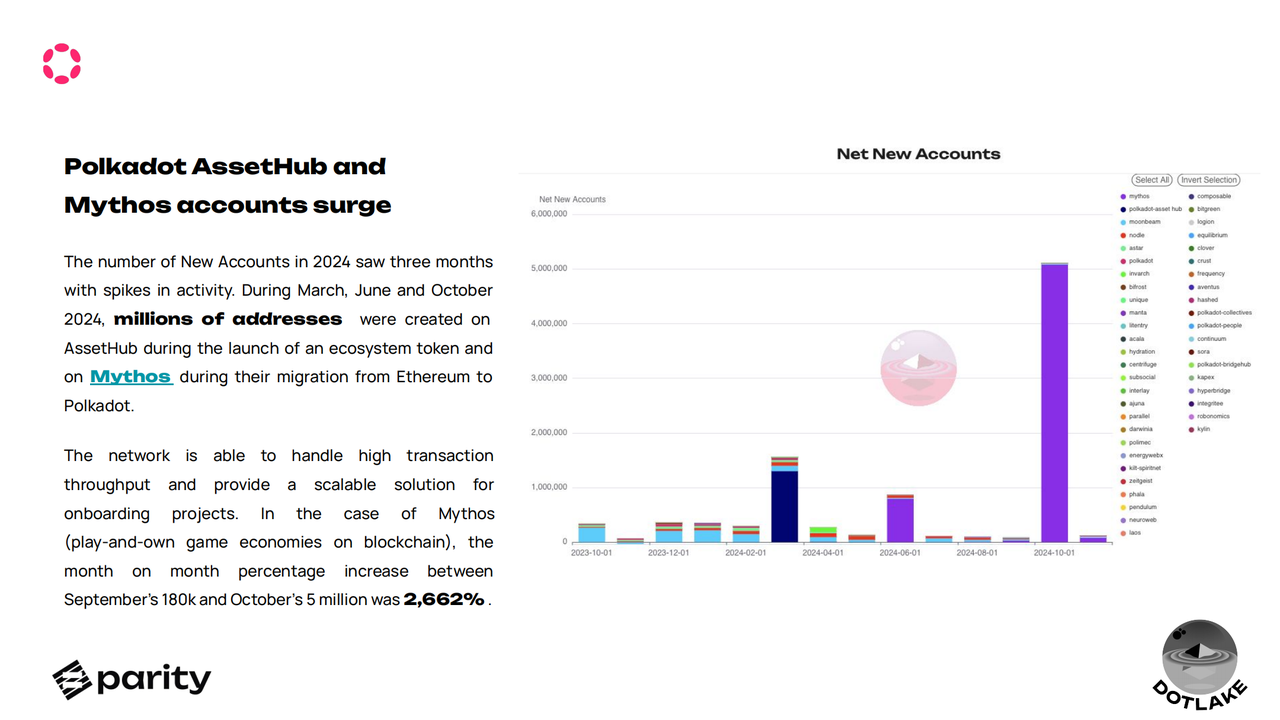
Decentralized Governance: Proposals and
Financial expenditure is transparent and efficient
Polkadot's decentralized governance system provides a wide range of opportunities for community participation. In 2024, 950+ proposals have been launched on OpenGov, of which 520+ have been passed. The Polkadot Treasury currently controls assets worth approximately $217 million , and the Treasury has spent $129 million in 2024.
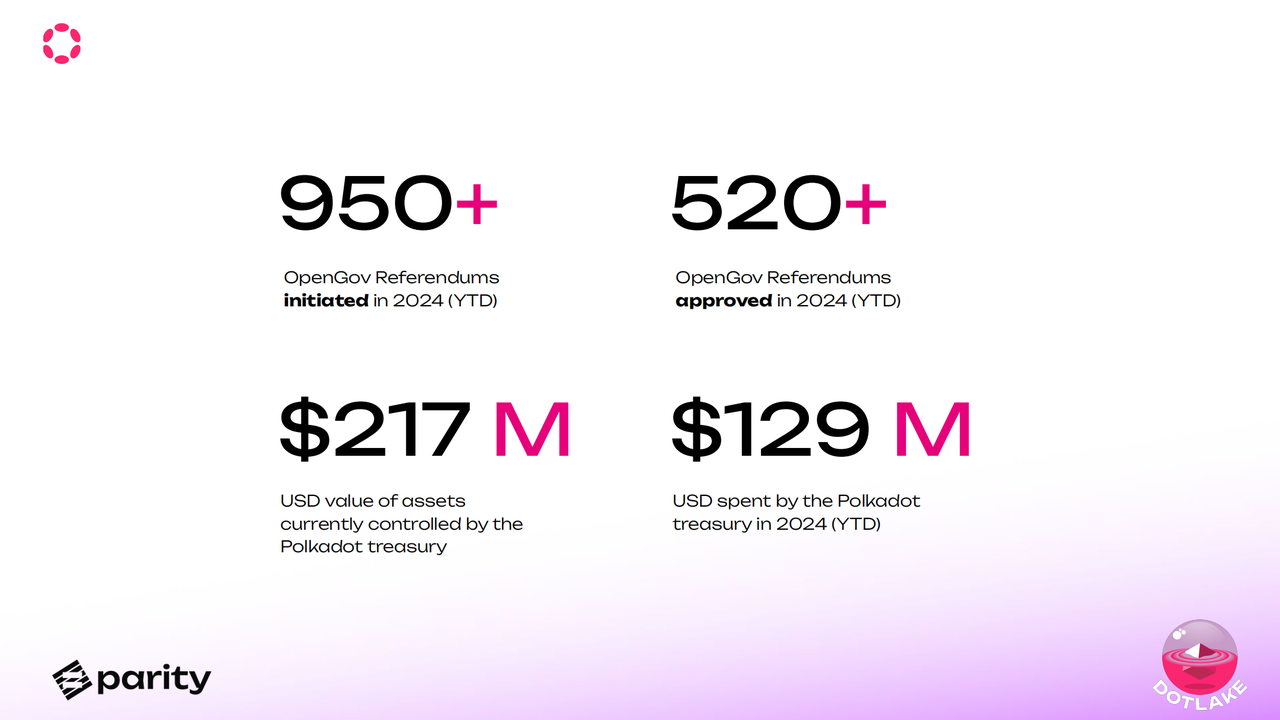
Categorized by referendum type, about 77% of the 950 referendums were treasury-related proposals . Medium Spender and Small Spender were the largest categories, with 296 and 124 referendums respectively.
Compared to 2023, treasury spending in 2024 increased significantly, by 3.2 times. Spending peaked in April and May 2024 and has since declined month by month. In 2024, Polkadot's treasury spent $58.82 million on outreach to support community and ecosystem growth. The second largest category was Development , with an investment of $28.73 million, and the third was Economy, with a spending of $17.24 million. Other categories include Research, Operations, and Talent & Education , ranging between $7.6 million and $8.6 million, respectively.

The booming Polkadot ecosystem
Polkadot’s Rollups (also known as “parachains”) are specialized blockchains at the core of the Polkadot architecture, enabling scalability, interoperability, and customization . These parachains support a variety of use cases - from smart contracts and privacy to asset management, providing teams with tailored solutions while benefiting from the strong shared security of the Relay Chain. System chains provide essential network services such as asset management, governance frameworks, identity management, and trustless bridging, ensuring that the broader ecosystem has a scalable and secure foundation for continued growth.
User growth and ecosystem expansion
In 2024, the number of independent accounts in the Polkadot ecosystem increased by 150% , from 5.2 million in January 2024 to 13.2 million in November 2024. It is worth noting that the Mythos chain, which was newly added to the ecosystem, contributed nearly 6 million new addresses , and these accounts were subsequently successfully migrated to its Rollup platform.
Stablecoin development and application innovation
In 2024, Polkadot launched an innovative stablecoin feature that allows DOT holders to apply for stablecoins directly from the treasury, providing more stable support for project budget management. Stablecoins have experienced significant growth this year, with their total USD value increasing from approximately $22 million at the beginning of the year to approximately $90 million . Among them, Asset Hub, Hydration, and Moonbeam have become the three largest Rollups in terms of stablecoin holdings.
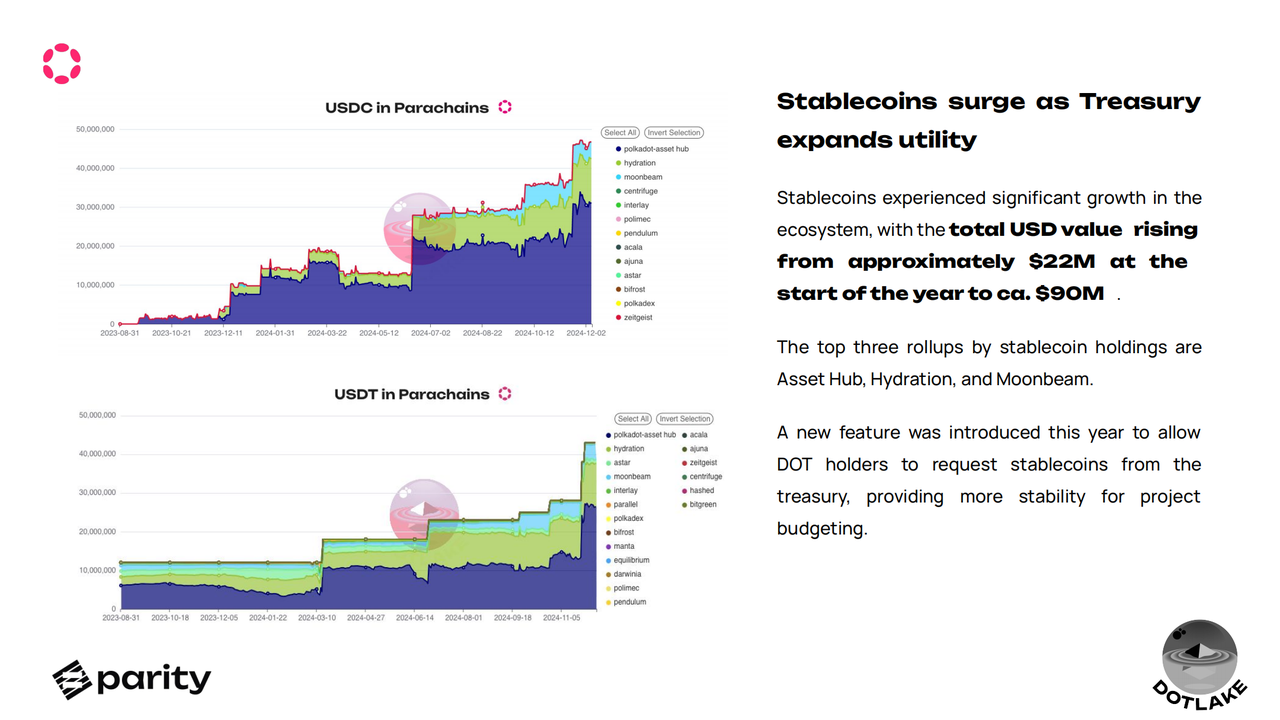
XCM is fully upgraded to improve interoperability
Polkadot XCM (Cross-Chain Messaging) enables cross-chain communication in a trustless manner, supports the exchange of assets and data, and provides a secure and efficient solution for cross-chain interactions. In 2024, the number of XCM messages grew steadily, exceeding 40,000 in October and continuing to climb in November. In the future, after XCMP is completed, it will replace the existing HRMP, UMP, and DMP mechanisms to further simplify the cross-chain communication process. In addition, 26 new HRMP channels were added in 2024, bringing the total to more than 120, establishing efficient channels between unconnected Rollups and improving the interoperability and flexibility of the network.
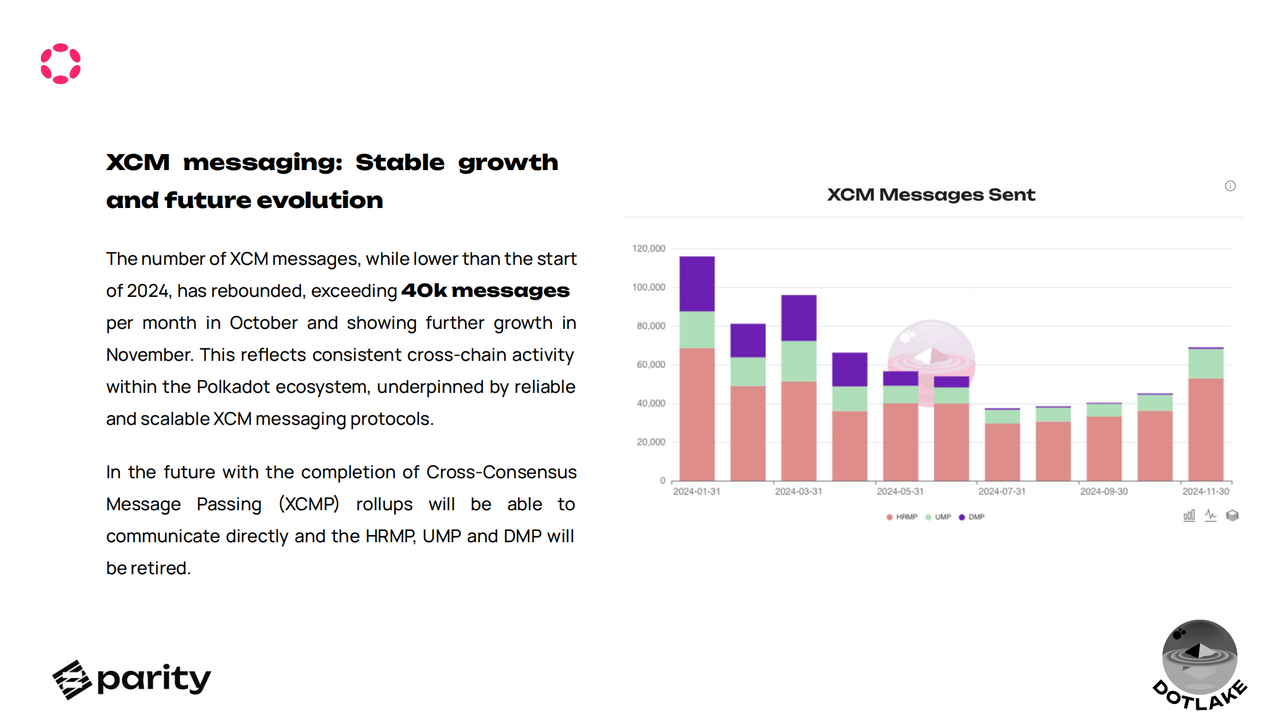
The developer ecosystem continues to be active
As one of the most active developer communities in the blockchain industry, there are currently 1,273 developers active in more than 270 code bases in the Polkadot ecosystem, of which chain and Pallet developers are the largest (457) , followed by tool and API developers (273) and wallet developers (188) .

As an important driving force for technological innovation and decision-making, the number of members of the Polkadot Technical Fellowship increased from 47 to 99 in 2023. The committee is not only responsible for accelerating the governance process, but also provides financial support for key technical proposals. In addition, educational programs such as the Polkadot Blockchain Academy , funded by the Ecosystem Fund, have effectively attracted and trained more developers, injecting new impetus into the development of the ecosystem.
Looking Ahead to 2025: The Future of Polkadot
Technological breakthroughs and ecological development plans
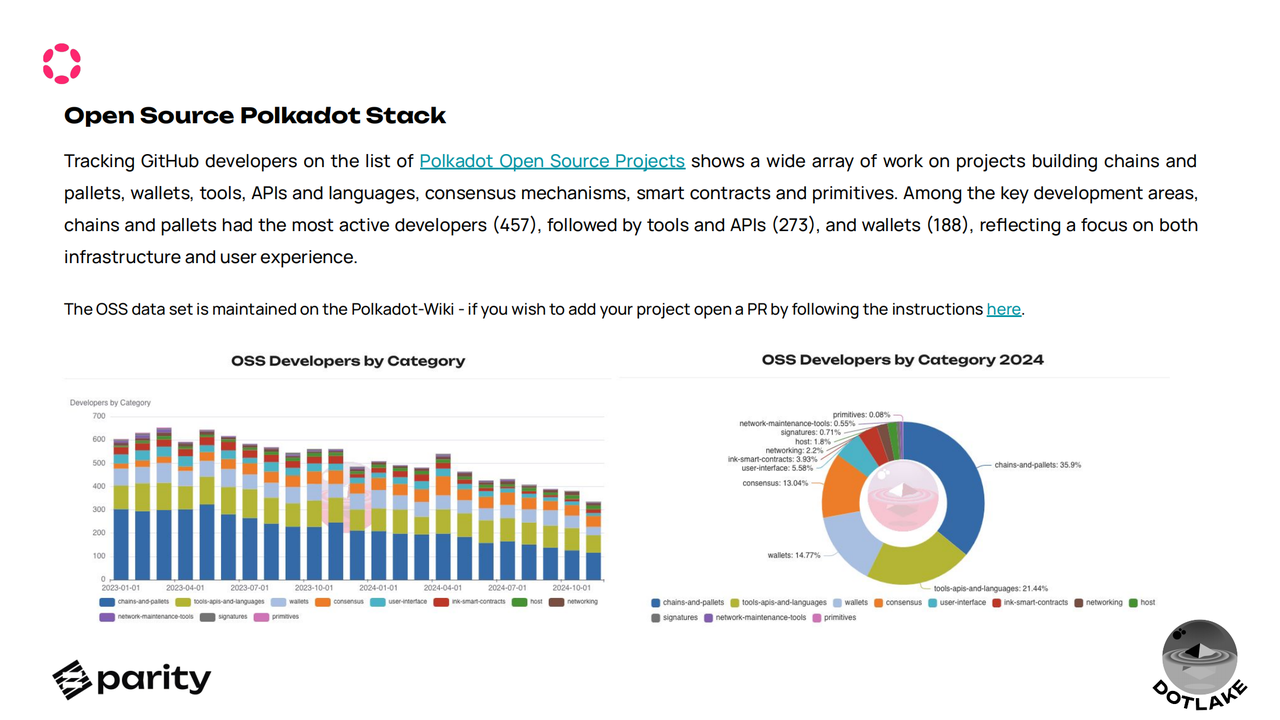
Looking ahead to 2025, Polkadot will continue to lead the Web3 ecosystem through the following technological innovations:
Smart Contracts: Asset Hub will be upgraded to support EVM and Solidity.
Elastic expansion: realize multi-core parallel processing.
XCM v5: A new upgrade of cross-chain communication to enhance interoperability.
PVM: A lightweight virtual machine based on RISC-V that supports fast, secure and scalable smart contracts.
Unified address format: Provides a single address applicable to Polkadot and all Rollups.
Fast unstaking: Shorten the waiting time for DOT unstaking.
Unified payment: DOT will be used as a fee token to improve user experience.
JAM SDK: Provides seamless development tools and supports extensible services.
SAFROLE Optimization: Optimizing block production using zkSNARK technology.
Omni Node: Provides a unified node solution for Polkadot Rollup.
Conclusion
In 2024, the Polkadot ecosystem has made significant progress in many aspects such as technological innovation, ecological expansion and governance optimization. From the introduction of the Coretime model to the new performance record set by the Spammening test, to the continuous optimization of decentralized governance and cross-chain interoperability, Polkadot is constantly consolidating its leading position as the core infrastructure of Web3. Looking forward to 2025, Polkadot will continue to promote the transformation and progress of the blockchain industry through a number of technological upgrades and ecological construction. The future is here, let us look forward to Polkadot writing more brilliant chapters on the road of innovation and expansion of boundaries.












